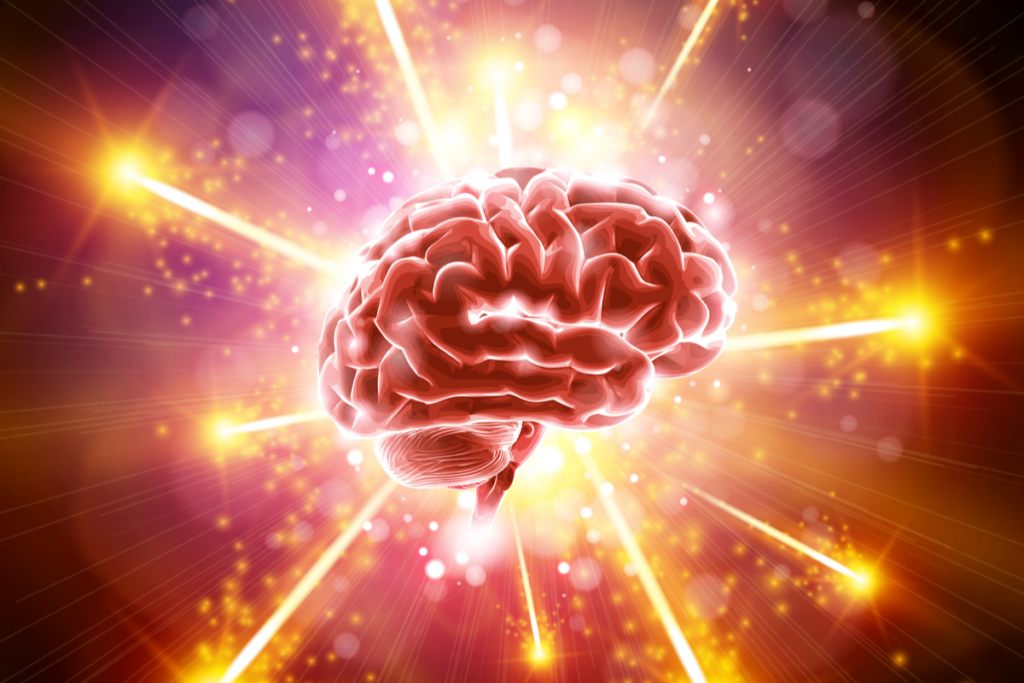The Brains of Migraine Sufferers Work Differently

In our society, there are numerous invisible diseases. Migraine is one of them. It’s not just a simple headache. In fact, the migraine sufferer has to give up many things in their life. When an attack appears, they find it impossible to socialize, perform at work, or even carry out the most basic of tasks.
We could say that the ‘stigma’ of migraine makes living with this disease even more complicated. In this regard, neurological researchers have studied the history of the condition. They discovered that, in the 18th century, people viewed migraine sufferers as weak and irresponsible. In addition, they thought that they used the condition as a justification for evading their social duties.
Unfortunately, this discriminatory perspective hasn’t completely disappeared. However, encouragingly, science today is committed to understanding the mechanisms behind it. So much so, that they frequently update investigations to further outline this disabling reality.
The brain of the migraine sufferer doesn’t work in the same way as those of the rest of us. Indeed, only those who live with this disease know what it’s like to be the prisoner of a pain that originates in the depths of their neural networks.
It usually appears in adolescence, sometimes even in childhood. From then on, it becomes that unwelcome guest who appears far too often and might stay for up to three days in a row.
Understanding the mechanisms of migraine will allow us to find more appropriate treatments.

The brains of migraine sufferers are different
Migraine is a neurovascular disease of genetic origin. It affects around ten percent of people worldwide. Women are more likely to suffer from the condition. Annoyingly, it can take sufferers up to two years to find a suitable treatment that provides them with an adequate quality of life. That’s because ordinary painkillers don’t work.
As a rule, a proper diet and a series of specialized drugs can provide some control over this condition. There’s no cure at the moment, but we know that it’s a disorder caused by brain hyperactivity. Therefore, it can be treated with medicines designed for this symptom.
However, to guarantee the migraine sufferer’s well-being, it’s important that they understand the anatomy of the illness. This will give them a broader and more comprehensive vision of what’s happening to them. Moreover, today, there are many improved ways of coping with pain. In addition, interestingly, migraine sufferers exhibit certain neurological peculiarities.
If you suffer from migraine, don’t be left in the dark. Look for accredited information, specialized professionals, and support groups.
Alterations in blood flow and metabolic activity of the cortex
A few years ago, the University of California (USA) conducted research on migraine sufferers. They discovered that there are certain notable anatomical components in the brains of migraine sufferers. Firstly, there are alterations in the blood flow and in the metabolic activity of the cerebral cortex.
In addition, a striking cortical excitability exists. This is linked to cerebral hyperactivity. It explains many symptoms, from abnormal visual sensations to sensitivity to smell. While they’re minor characteristics, they demonstrate the neurological origin of this disease that has such a tremendous effect on the lives of sufferers.
The brainstem in migraine sufferers works differently
The brainstem is the signaling region between the brain and the spinal cord. It regulates basic involuntary functions. Much of the pathophysiology of migraines come from this area. In effect, there’s an alteration in the brainstem. This leads to dizziness, vertigo, nausea, etc.
The trigeminal pathway and throbbing pain
At present, there are certain therapies for migraine aimed at promoting the stimulation of the trigeminal nerve to reduce pain signals. Experts have recognized the influence of the trigeminovascular system in the development of this disease for some time. It’s linked to the calcitonin gene (CGRP).
This is a neuropeptide that increases jugular venous blood flow during a migraine attack, hence the excruciating, throbbing pain.
Migraine is a common neurological disorder characterized by a complex pathophysiology, ranging from hyperexcitability to certain genetic alterations.
Glial cells and vascular cells in the brains of migraine sufferers
Another unique peculiarity in the brains of migraine sufferers is that electrocortical signals between glial and vascular cells are impaired. This neuronal excitability can be seen in magnetic resonance images. Furthermore, it’s made it possible to improve the drugs used in its treatment.

Abnormalities in the structure of the brain
As you probably know, there are different types of migraine. For example, there are those with aura and those without, retinal, hemiplegic, etc. A study conducted by various universities discovered that the different types of migraine cause abnormalities of the white matter and the gray matter. They’re lesions, similar to those caused by a stroke.
Some recommendations
The data we’ve mentioned might sound overwhelming and confusing. Indeed, learning that the brain exhibits all these small alterations is often frightening. However, as we mentioned earlier, science is continuing to advance and the most important thing is to have specialized support. Also, to find the treatments that best suit each individual type of migraine.
If you’re a migraine sufferer, we recommend the following:
- Find out about the disease from authorized and expert sources and organizations.
- Look for the most suitable health professionals. For example, those who give you the most confidence and empathy.
- Look for support groups and people who are going through the same thing.
- Take care of your diet. Also, avoid products that contain histamine.
- Learn techniques for regulating stress.
- Integrate relaxation techniques into your life.
- Undertake some physical activity.
- Take care of your sleeping habits.
- Know the triggers that activate your migraines.
Unfortunately, there’s currently no treatment to cure this neurological disease. However, there are resources that allow the migraine sufferer to have a good quality of life.
In our society, there are numerous invisible diseases. Migraine is one of them. It’s not just a simple headache. In fact, the migraine sufferer has to give up many things in their life. When an attack appears, they find it impossible to socialize, perform at work, or even carry out the most basic of tasks.
We could say that the ‘stigma’ of migraine makes living with this disease even more complicated. In this regard, neurological researchers have studied the history of the condition. They discovered that, in the 18th century, people viewed migraine sufferers as weak and irresponsible. In addition, they thought that they used the condition as a justification for evading their social duties.
Unfortunately, this discriminatory perspective hasn’t completely disappeared. However, encouragingly, science today is committed to understanding the mechanisms behind it. So much so, that they frequently update investigations to further outline this disabling reality.
The brain of the migraine sufferer doesn’t work in the same way as those of the rest of us. Indeed, only those who live with this disease know what it’s like to be the prisoner of a pain that originates in the depths of their neural networks.
It usually appears in adolescence, sometimes even in childhood. From then on, it becomes that unwelcome guest who appears far too often and might stay for up to three days in a row.
Understanding the mechanisms of migraine will allow us to find more appropriate treatments.

The brains of migraine sufferers are different
Migraine is a neurovascular disease of genetic origin. It affects around ten percent of people worldwide. Women are more likely to suffer from the condition. Annoyingly, it can take sufferers up to two years to find a suitable treatment that provides them with an adequate quality of life. That’s because ordinary painkillers don’t work.
As a rule, a proper diet and a series of specialized drugs can provide some control over this condition. There’s no cure at the moment, but we know that it’s a disorder caused by brain hyperactivity. Therefore, it can be treated with medicines designed for this symptom.
However, to guarantee the migraine sufferer’s well-being, it’s important that they understand the anatomy of the illness. This will give them a broader and more comprehensive vision of what’s happening to them. Moreover, today, there are many improved ways of coping with pain. In addition, interestingly, migraine sufferers exhibit certain neurological peculiarities.
If you suffer from migraine, don’t be left in the dark. Look for accredited information, specialized professionals, and support groups.
Alterations in blood flow and metabolic activity of the cortex
A few years ago, the University of California (USA) conducted research on migraine sufferers. They discovered that there are certain notable anatomical components in the brains of migraine sufferers. Firstly, there are alterations in the blood flow and in the metabolic activity of the cerebral cortex.
In addition, a striking cortical excitability exists. This is linked to cerebral hyperactivity. It explains many symptoms, from abnormal visual sensations to sensitivity to smell. While they’re minor characteristics, they demonstrate the neurological origin of this disease that has such a tremendous effect on the lives of sufferers.
The brainstem in migraine sufferers works differently
The brainstem is the signaling region between the brain and the spinal cord. It regulates basic involuntary functions. Much of the pathophysiology of migraines come from this area. In effect, there’s an alteration in the brainstem. This leads to dizziness, vertigo, nausea, etc.
The trigeminal pathway and throbbing pain
At present, there are certain therapies for migraine aimed at promoting the stimulation of the trigeminal nerve to reduce pain signals. Experts have recognized the influence of the trigeminovascular system in the development of this disease for some time. It’s linked to the calcitonin gene (CGRP).
This is a neuropeptide that increases jugular venous blood flow during a migraine attack, hence the excruciating, throbbing pain.
Migraine is a common neurological disorder characterized by a complex pathophysiology, ranging from hyperexcitability to certain genetic alterations.
Glial cells and vascular cells in the brains of migraine sufferers
Another unique peculiarity in the brains of migraine sufferers is that electrocortical signals between glial and vascular cells are impaired. This neuronal excitability can be seen in magnetic resonance images. Furthermore, it’s made it possible to improve the drugs used in its treatment.

Abnormalities in the structure of the brain
As you probably know, there are different types of migraine. For example, there are those with aura and those without, retinal, hemiplegic, etc. A study conducted by various universities discovered that the different types of migraine cause abnormalities of the white matter and the gray matter. They’re lesions, similar to those caused by a stroke.
Some recommendations
The data we’ve mentioned might sound overwhelming and confusing. Indeed, learning that the brain exhibits all these small alterations is often frightening. However, as we mentioned earlier, science is continuing to advance and the most important thing is to have specialized support. Also, to find the treatments that best suit each individual type of migraine.
If you’re a migraine sufferer, we recommend the following:
- Find out about the disease from authorized and expert sources and organizations.
- Look for the most suitable health professionals. For example, those who give you the most confidence and empathy.
- Look for support groups and people who are going through the same thing.
- Take care of your diet. Also, avoid products that contain histamine.
- Learn techniques for regulating stress.
- Integrate relaxation techniques into your life.
- Undertake some physical activity.
- Take care of your sleeping habits.
- Know the triggers that activate your migraines.
Unfortunately, there’s currently no treatment to cure this neurological disease. However, there are resources that allow the migraine sufferer to have a good quality of life.
All cited sources were thoroughly reviewed by our team to ensure their quality, reliability, currency, and validity. The bibliography of this article was considered reliable and of academic or scientific accuracy.
- Amiri, P., Kazeminasab, S., Nejadghaderi, S., et al. (2022). Migraine: a review on its history, global epidemiology, risk factors, and comorbidities. Frontiers in Neurology, 12, 1-15. Disponible en: https://www.ncbi.nlm.nih.gov/pmc/articles/PMC8904749/#:~:text=Migraine%20affects%20more%20than%20one,among%20young%20adults%20and%20females.
- Bashir, A., Lipton, R., Ashina, S. & Ashina, M. (2013). Migraine and structural changes in the brain: a systematic review and meta-analysis. Neurology, 81(14), 1260-1268. Disponible en: https://www.ncbi.nlm.nih.gov/pmc/articles/PMC3795609/
- Bartley, J. (2009). Could glial activation be a factor in migraine? Medical hypotheses, 72(3), 255-257. Disponible en: https://www.sciencedirect.com/science/article/abs/pii/S0306987708005410?via%3Dihub
- Bonanno, L., Lo Buono, V., De Salvo, S., et al. (2020). Brain morphologic abnormalities in migraine patients: an observational study. The journal of headache and pain, 21(1), 1-6. Disponible en: https://thejournalofheadacheandpain.biomedcentral.com/articles/10.1186/s10194-020-01109-2
- Charles, A. & Brennan, K. C. (2010). The neurobiology of migraine. In G. Nappi and M.A. Moskowitz (Eds.). Handbook of clinical neurology (pp. 99-108). Elsevier. Disponible en: https://www.ncbi.nlm.nih.gov/pmc/articles/PMC5494713/
- Chong, C., Plasencia, J., Frakes, D. & Schwedt, T. (2017). Structural alterations of the brainstem in migraine. NeuroImage: Clinical, 13, 223-227. Disponible en: https://www.ncbi.nlm.nih.gov/pmc/articles/PMC5157793/
- Cutrer, F. M. & Black, D. F. (2006). Imaging findings of migraine. Headache: The Journal of Head and Face Pain, 46(7), 1095-1107. Disponible en: https://pubmed.ncbi.nlm.nih.gov/16866714/
- Filippi, M., & Messina, R. (2020). The chronic migraine brain: what have we learned from neuroimaging? Frontiers in neurology, 10(1356), 1-10. Disponible en: https://www.frontiersin.org/articles/10.3389/fneur.2019.01356/full
- Noseda, R. & Burstein, R. (2013). Migraine pathophysiology: anatomy of the trigeminovascular pathway and associated neurological symptoms, cortical spreading depression, sensitization, and modulation of pain. Pain, 154, 44-53. Disponible en: https://www.ncbi.nlm.nih.gov/pmc/articles/PMC3858400/#:~:text=Most%20likely%2C%20migraine%20headache%20depends,of%20neuronal%20excitability%20and%20pain.
- Planchuelo-Gómez, Á., García-Azorín, D., Guerrero, et al. (2020). White matter changes in chronic and episodic migraine: a diffusion tensor imaging study. The Journal of Headache and Pain, 21, 1-15. Disponible en: https://www.ncbi.nlm.nih.gov/pmc/articles/PMC6941267/#:~:text=Background,two%20groups%20of%20migraine%20patients.
- Yuan, H. & Silberstein, S. D. (2018). Histamine and migraine. Headache: The journal of head and face pain, 58(1), 184-193. Disponible en: https://headachejournal.onlinelibrary.wiley.com/doi/abs/10.1111/head.13164
- Yung, W. (2018). The Stigma of Migraine. Practical Neurology. Disponible en: https://practicalneurology.com/articles/2018-feb/the-stigma-of-migraine
This text is provided for informational purposes only and does not replace consultation with a professional. If in doubt, consult your specialist.







